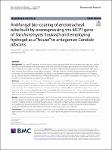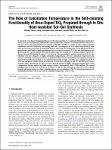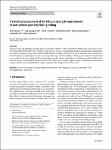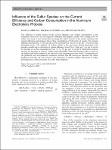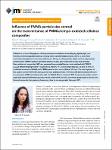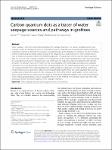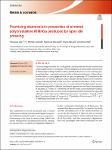Search
Author
- Manyk, T. (3)
- Murawski, K. (3)
- Baumgartner, Jörg (2)
- Guizani, Chamseddine (2)
- next >
Subject
Date issued
- 2023 (187)
Has File(s)
- true (187)
Search Results
For some ICU patients, an artificial airway must be established with an endotracheal tube, but Candida albicans can easily adhere to the tube surface and form a biofilm, leading to potentially life threatening fungal infections. Therefore, it is urgent to prevent and reduce C. albicans infections introduced by the endotracheal tube. However, there are few antifungal drugs effective against C. albicans, and each of these drugs may have adverse effects on human cells. Saccharomyces boulardii is regarded as an alternative strategy to inhibit the adhesion of C. albicans, but it is affected by environmental stress. We hypothesized that it is feasible to strengthen the antagonistic ability of S. boulardii via encapsulating and genetically modification. |
In this study, urea-doped titanium dioxide (urea-TiO2) nanoparticles were synthesized through an in situ heat-assisted sol–gel technique using titanium (IV) isopropoxide as the precursor for titanium dioxide and urea as a nitrogen source. The nanoparticles were calcined at 300, 500, and 700 °C to study the effect of the calcination temperature on their function as self-cleaning material. The nanoparticles were characterized using a scanning electron microscope and a transmission electron microscope for morphology, X-ray diffraction, Raman spectroscopy, and Fourier transformed infrared spectroscopy for structure, UV–Vis, and photoluminescence spectroscopy for optical analysis. The self-cleaning study was carried out by letting samples degrade methylene blue and Rhodamine-B under UV i... |
A statistical assessment of the fatigue strength improvement of butt-welded joints by flush grinding All major rules and guidelines include fatigue design (FAT) classes for flush ground butt-welded joints. These FAT classes vary between FAT110 and FAT155; however, in the majority of cases, the underlying database and specimen-related details are unclear or unknown. This study evaluates 1003 fatigue test results gathered from various literature sources and tries to relate the fatigue strength improvement to typical specimen types and test conditions. To this goal, statistical methods based on correlation analysis are employed. Next, proposals for updates of rules and guidelines for flush ground butt-welded joints made of steel are established by determining new FAT classes and a suitable slope exponent. In addition, an overview of design standards and recommendations is given and ma... |
Model alloys, Fe–20Cr and Fe–20Cr–20Ni (wt%) with and without 1% Si, were exposed to four different gas mixtures Ar–10H2O, Ar–10H2O–0.1HCl, Ar–10H2O–0.1HCl–10CO2, Ar–10H2O–0.1HCl–10CO2–0.5SO2 (vol.%) at 650 °C. The Fe–20Cr and Fe–20Cr–20Ni alloys underwent breakaway corrosion in Ar–10H2O–(0.1HCl)–(10CO2), forming Cr2O3 and Fe-rich oxide nodules. Silicon addition markedly increased corrosion resistance for both alloys by forming an additional SiO2 layer beneath the Cr2O3 scale. Addition of SO2 to Ar–10H2O–0.1HCl–10CO2 significantly suppressed the formation of Fe-rich oxide nodules on Fe–20Cr. Corrosion in the SO2-bearing gas resulted in (Cr, Fe, S)-rich precipitates in all alloys. The effects of gas composition and Si alloying on corrosion of both alloys are discussed in terms of tra... |
The influence of sulfur species on the current efficiency and carbon consumption in the aluminum electrolysis was investigated. Prebaked and graphite anodes with varying levels of sulfur were used. It was found that increasing the sulfur content in the anodes decreases the current efficiency and increases the carbon consumption of both types of anodes. The current efficiency decreased by 1.3 pct and the carbon consumption rose by 6.1 pct per 1 wt pct S in the prebaked anodes. The addition of sodium sulfate to the electrolyte during electrolysis with graphite anodes led to a decrease in current efficiency from 0.9 to 1.0 pct per 1 wt pct S, and to an increase in carbon consumption from 3.1 to 7.0 pct per 1 wt pct S. Electrolyte analysis showed the presence of sulfates, sulfides and p... |
Cellulose is a class of biopolymers that prominently contributes to developing lightweight, eco-friendly, and biodegradable plastics. Among them, nanofibrillated cellulose (NFC) is one of the most interesting due to its mechanical behavior. Mixing it with synthetic plastic such as poly(methyl methacrylate) (PMMA) reduces synthetic polymer usage, agro-industrial residue and develops fiber-reinforced composites. NFC was prepared from residual biomass and oxidized with TEMPO (2,2,6,6-tetramethylpiperidine-1-oxyl radical). Herein, NFC was incorporated (25, 50 and 75 wt%) in a colloidal emulsion of PMMA, with PMMA particle size control (50 and 175 nm). The investigation of this system on the PMMA/NFC transparency was addressed here. |
Run-time device-level reconfigurability has the potential to boost the performance and functionality of numerous circuits beyond the limits imposed by the integration density. The key ingredient for the implementation of reconfigurable electronics lies in ambipolarity, which is easily accessible in a substantial number of two-dimensional materials, either by contact engineering or architecture device-level design. In this work, we showcase graphene as an optimal solution to implement high-frequency reconfigurable electronics. We propose and analyze a split-gate graphene field-effect transistor, demonstrating its capability to perform as a dynamically tunable frequency multiplier. The study is based on a physically based numerical simulator validated and tested against experiments. |
Vanessa Zamora Mora and Roberto de Mezerville are salaried employees of the Establishment Labs company. Ardeshir Bayat is a co-inventor on a number of patents that were assigned to the Establishment Labs company and he is also a financially compensated member of the scientific advisory board of the same company. |
Water seepage is one of the main factors leading to the damage of grottoes. The sources and pathways of water seepage need to be identified to relieve it. Although the sources and pathways are investigated using geophysical exploration methods commonly, the results are unsatisfactory due to the limitation of resolution. The tracer method has been widely used to examine water seepage in the natural sciences and engineering. However, most tracers have an impact on grottoes, making this method inapplicable. This study was the first to use the carbon quantum dots as a tracer of water seepage in grottoes. The characteristics of the carbon quantum dots, which was synthesized by various biomass precursors through large-scale synthesis in the field, were analyzed to determine the optimal pr... |
The increasing interest in the development of multicaloric materials for solid-state cooling applications is giving rise to the investigation of elastocaloric performance of ferromagnetic Shape Memory Alloys (FeSMA). Moreover, some sintering processes have been proposed to overcome the well-known brittleness of these alloys. In this context, a novel application of the open die pressing (ODP) method for the preparation of NiMnGa polycrystalline samples sets the chance to have interesting mechanical properties, until now never reported in literature. In this work, a tunable optimization of microstructure is presented and the elastocaloric properties are investigated by different mechanical approaches and direct measurement of adiabatic ΔT values. It is observed, for the first time, a ... |

